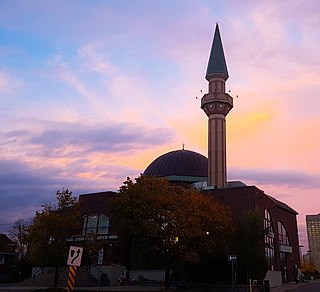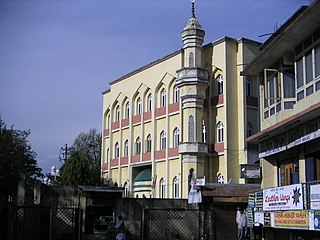
Islam in Canada is a minority religion practised by approximately 5% of the population. A majority of Muslims are of immigrant backgrounds consisting a diverse range of ethnic groups. Muslims have lived in Canada since 1871 and the first mosque was established in 1938. Most Canadian Muslims are Sunni, while a significant minority are Shia and Ahmadiyya.

Islam has been practiced in China since the 7th century CE. Muslims are a minority group in China, representing 1 to 1.5 percent of the total population according to a book. Though Hui Muslims are the most numerous group, the greatest concentration of Muslims are in Xinjiang, which contains a significant Uyghur population. Lesser yet significant populations reside in the regions of Ningxia, Gansu and Qinghai. Of China's 55 officially recognized minority peoples, ten of these groups are predominantly Sunni Muslim.

Islam is the second largest religion in the Netherlands, after Christianity, and is practised by 5% of the population according to 2018 estimates. The majority of Muslims in the Netherlands belong to the Sunni denomination. Many reside in the country's four major cities: Amsterdam, Rotterdam, The Hague and Utrecht.

Islam in Switzerland has mostly arrived via immigration since the late 20th century. Numbering below 1% of total population in 1980, the fraction of Muslims in the population of permanent residents in Switzerland has quintupled in thirty years, estimated at just above 5% as of 2013. A majority is from Former Yugoslavia ; an additional 20% is from Turkey. This is due to the fact that in the 1960s and 1970s, Switzerland encouraged young men from Yugoslavia and Turkey to come as guest workers. Initially these young men were only planning on staying in Switzerland temporarily, however, revised Swiss immigration laws in the 1970s permitted family regrouping. Consequently, these men ended up staying in Switzerland as these new laws allowed the wives and children of these young men into the country. Since this time period, most of the Muslim immigration to Switzerland stems from asylum seekers arriving primarily from Eastern Europe.

Guatemala is a predominantly Christian country, with Islam being a small minority religion. Due to secular nature of the Guatemala's constitution, Muslims are free to proselytize and build places of worship in the country.

The history of Islam in Japan is relatively brief in relation to the religion's longstanding presence in other nearby countries, and forms a minority of its historical and current population. Islam is one of the smallest minority faiths in Japan, representing around 0.18% of the total population as of 2019. Despite a small initial population base, immigration from Muslim majority countries has made Islam one of the fastest growing religions in the country in terms of percentage increase, with its followers growing by approximately 110%, from 110,000 in 2010 to 230,000 at the end of 2019, out of the total population of Japan of around 126 million.

Cuba is a majority Christian nation, with Islam being one of the smallest minority faiths in the country. According to a 2011 Pew Research Center report, there were then 10,000 Muslims in Cuba who constitute less than 0.1% of the population. As of 2012, most of the 10,000 Cuban Muslims were converts to the religion.

Honduras is a predominantly Christian country, with Islam being a small minority religion. Due to secular nature of the country's constitution, Muslims are free to proselytize and build places of worship in the country. The statistics for Islam in Honduras estimate a total Muslim population of 11,000 representing 0.1 percent of the population.

The statistics for Islam in Antigua and Barbuda estimate a total Muslim population of about 200, representing 0.3 percent of the total population of 67,448. Most of the Muslims of the islands are Arabs of Syrian or Lebanese descent. There are two known Islamic organizations in St. John's, including the Antigua and Barbuda International Islamic Society and the American University of Antigua Muslim Students Association. There is also an Ahmadiyya mission in Antigua. Outside St. John's, there is the Muslim Community of Antigua and Barbuda in Codrington, Barbuda. A Pew Research Center survey in 2016 calculated the total number to be around 950.

Islam in Colombia is a minority religion, with most Colombians adhering to Christianity (Catholicism). According to a 2018 study conducted by Pew Research Center, the size of the Colombian Muslim population ranges from about 85,000–100,000 people out of a total population of 50.4 million. However, according to official estimates the Colombian Muslim community numbered just 10,000 people or 0.02% of the total Colombian population. Most Colombian Muslims are immigrants from the Arab World along with a small number of local converts.

Peru is a predominantly Christian country, with Muslims being a very small minority. Due to secular nature of the Peru's constitution, Muslims are free to proselytize and build places of worship in the country. The statistics for Islam in Peru estimate a total Muslim population of 15,000, largely based in the capital city Lima; this represents 0.015% out of total population of 32,555,000 inhabitants.

Islam is the second largest religion in Norway after Christianity. As of 2023, the number of Muslims living in Norway was 182,607. The majority of Muslims in Norway are Sunni, with a significant Shia minority. 55 percent of Muslims in the country live in Oslo and Viken. The vast majority of Muslims have an immigrant background, and very few Norwegians are Muslim.

Finland is Christian majority country, with Islam being a minority faith. The constitution of Finland ensures freedom of religion and Muslims are free to proselytize and build places of worship in the country.

Islam in Hungary dates back to at least the 10th century. The influence of Sunni Islam was especially pronounced in the 16th century during the Ottoman period in Hungary.

Islam in the Indian Ocean was established by Muslim sea merchants well before the European discovery of Seychelles. However, unlike in other island states including the Comoros and Maldives, there were no permanent inhabitants in Seychelles until the French settlement in 1770. Today, the Muslim population of the islands is reported to be only 1.1%, roughly 900 people. Many of its island neighbors in the southern Indian Ocean, including Comoros, the Maldives and Zanzibar, have a much larger Muslim influence because of their settlement by Muslims, before European colonization. Mauritius also has a much higher Muslim population due to the importation of labour from British India on a scale not seen in Seychelles. The government of Seychelles allows 15 minutes of religious broadcasting every Friday for the Muslim community.

Islam is the third largest religion in Nepal. According to the 2021 Nepal census, approximately 1.483 million Muslims, comprising 5.09% of the population, live in Nepal.

Christianity is the dominant religion in Belize. The single largest denomination is the Catholic Church with about 40.1% of the population, a reduction from 49.6% of the population in 2000, 57.7% in 1991 and 61.9% in 1980, although absolute numbers have still risen. Other major groups include Pentecostal with 8.4% of the population up from 7.4% in 2000 and 6.3% in 1991, Seventh-day Adventists with 5.4% of the population up from 5.2% in 2000 and 4.1% in 1991. The following of the Anglican Church has been steadily declining, with only 4.7% of the population in 2010 compared to 6.95% in 1991. About 12,000 Mennonites live mostly in the rural districts of Cayo and Orange Walk. People who declared they belong to no religion make up 15.5% of the population in 2010, more than double their 2000 census numbers. 11.2% adhere to other religions which include the Maya religion, Afro-Caribbean religions, Mormons, Hindus, Buddhists, Muslims, Baháʼís, Rastafarians and others.
The population of Dubai is estimated to be 3.5 million as of April 2022 according to government data. As of 2021, 3.2 million were non-Emirati, and 69% were male. About 58.50% of the population is concentrated in the 25-44 age group. This unnatural age and gender distribution is due to the large proportion of foreign workers, most of whom are working-age males. Life expectancy at birth was 81 years for males, and 82.1 for females.

Contacts with the Muslim world dates back to the 7th–10th centuries, when the Vikings traded with Muslims during the Islamic Golden Age. Since the late 1960s and more recently, immigration from predominantly Muslim countries has impacted the demographics of religion in Sweden, and has been the main driver of the spread of Islam in the country.









